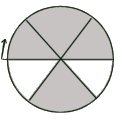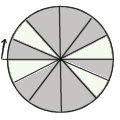An Analysis of Rhythmic Modes in Middle Eastern Music (pre-1600)
Note: These is a class handout that goes along with a class I taught at Pennsic 2001, so it may sound slightly incomplete standing alone.
Visit this page online at: http://www.khafif.com/rhy/rhyhist.html
I focus on "Arabic tradition" -- that is, the culture that grew into
(and later) out of the Arabic empire. This cultural tradition with
it's roots in the caravan and nomadic people and the Islamic religion,
later had deep, long-lasting effects on the cultures of Persia,
Turkey, and North Africa. The Arabic music culture grew from a vocal,
chanted-song tradition of early caravan traders and was tempered (by
academic scholars) with structural analysis of the early Greek musical
traditions. (For more information on this read Farmer [1].)
Challenges in Finding Period Documentation
Even though the Arabic world was a very scholarly place (relatively
speaking) in the middle ages, the academic traditions (especially in
the arts and performing arts) were not so analytical as in
european/western areas. Oral teaching tradition dominated (teachers
did not tend to write about technique), and third-party (audience)
descriptions of musical performances tended more toward the poetic or
evocative, rather than describing technique.
Since it's early roots Islamic culture has taken a schizophrenic view
of music. Listening to music for pleasure has always been a part of
the culture of art and hospitality in the Middle East. However,
during many periods, Islamic law has been interpreted in a way that
proscribed listening to or performing music except in worship of God.
Given this proscription there seems to have been less overlap of
academic scholarship with musical performers than one might expect.
Thus the accounts of musical technique tend toward the philosophical
rather than the practical.
The biggest problem, which affects much period Middle Eastern
research, is that the Monguls sacked the Arabic empire in the mid-13th
century. They focussed on elimination of the upper class and academic
resources; specifically killing scholars and burning libraries. One
notable exception to this purge was, in fact, Safi-al-Din who wound up
working for the Mongul court.
Period Sources
Arabic
-
Ibn Misjab ?-715.
-
-- first known theorist referred to by later authors. No surviving works.
-
Al-KindI (790-874 or 802-866).
-
-- Greek influence.
-- Few surviving works. Mentions names of rhythmic modes, but little
decipherable rhythmic theory.
-
Abu al-Faraj Ali of Esfahan, "KitAb al-Aghani al-Kabir", 10th c.
-
-- one of earliest theory works. Sections on music and rhythm
theory indecipherable.
-
FarabI (872-950), "KitAb al-MusiqI al-Kabir".
-
-- Content about melodic modes, mention of rhythmic mode
names found in later works, but little structural content.
-
Ibn Sina (980-1037)
-
-- More content about melodic modes, still little of rhythm
-
SafI-al-DIn, "KitAb Al-adwar", 1252 and "Risalat al-SarafIya", 1267.
-
-- First decipherable works. Most of known period rhythmic
theory (and much of melodic theory) is found here.
-
QoTb-al-DIn MaHmUd SIrAzI (1236-1311), "Dorrat al-tAj le-Gorrat al-dobbAj"
-
--Persian author essentially repeats SafI-al-Diin.
-
Zayn-al-'AabedIn MoHammad Hosaynii, "QAnUn-e 'elmI wa 'amalI-e mUsIqI", 1500.
-
--again, essentially repeats SafI-al-DIn.
Spanish
-
Alfonso X, el Sabio (1221-1284), "Cantigas de Santa Maria".
-
-- precise specifications for melodic intervals and modes,
but apparently no rhythmic mode or duration notation.
-- There have been attempts at reconstruction (Angles, Higinio) but
many scholars are critical of such work.
Period Transcriptions of Rhythmic Theory
There are four methods found in period Arabic works to represent rhythmic modes.
Poetic Feet
Early Arabic music was based on poetic meter. The first method uses Arabic words
to represent long and short syllables. It is not the meaning of the words that
is important, rather the rhythm in which they would be pronounced.
The Arabic language is based on tri-grams of consonants. Long and
short vowels, prefixes and postfixes modify these trigrams to make
families of words. In Arabic the long vowel is really longer in
duration than the short vowel (this is generally true in English as
well but less important that the sound).
For instance the trigram "K-T-B" involves writing:
- office = maktab (short - short)
- book = kitAb (short - long)
- writer = kAtib (long - short)
- write = kataba (short - short - short)
Notice the variety of long and short syllables.
Often the trigram "F-`-L" (means: to do) was used. This type of
mode description was used for music related to poetry. (Syllables that
"end" in a consonant were also considered "long" -- notice: F,', and L
are all "long" sounding consonants.)
It may be that the choice of word breaks indicates phrasing within
the cycle.
Synthetic Syllables
Also complete nonsense syllables were used to represent rhythm.
Typically something like "TAN" for a long syllable and "TA" for a
short. This method was used for non-poetic music and discussion of
pure rhythmic theory. In it's simplest form this method does not
indicate phrasing, however some authors used a different consonants
possibly to indicate this phrasing (mixing "TAN" and "TA" with "NAN"
and "NA") or possibly this was just to make it more pronounceable.
Dot Notation
The third method used was a notation of filled and un-filled dots.
Each dot was a fixed amount of time. Unfilled dots were struck, filled
dots left empty. Note that this method does not differentiate a
musical rest from a sustained note. It also shows no phrasing within
one rhythmic cycle.
Cycle Notation
The forth method used was a circular depiction of the mode. The
circle was divided into "pie slices". Shaded slices were struck,
un-shaded slices left empty. This is similar to the previous method
but reinforces the cyclic nature of rhythm. We assume that an even
time is given to each slice.
Here is a comparison of a couple of rhythmic modes in each method:
| Mode | hazaj | ramal |
| Poetic | fa-`a-lA-tUn

|
mUf-ta-`i-lA-tUn fa-`i-lUn
 |
| Syllabic | ta ta tan tan
ta na nan tan
| tan ta ta tan tan ta ta tan
tan ta na nan tan ta na nan
|
| Dots | o o o . o . | o . o o o . o. o o o . |
| Cycle |  |  |
The Documented Rhythmic Modes
Safi al-Din (via [2]): From the KitAb al-adwAr and Rissalla al-sharafiyya:
al-thaqIl al-awwal 16/8=3+3+4+2+4
1-+-2-+-3-+-4-+-|
Tt_Tt_Ttt_T-Ttt_|
______T---__T-__| al_aSl (the basis)
________T-__T-__| al-aSl
|
|
|
al-thaqIl al-thAnI 16/8=3+3+2+3+3+2
1-+-2-+-3-+-4-+-|
Tt_Tt_T-Tt_TT_T_|
T---________T-__| al-aSl
|
|
|
al-thaqIl al-thAnI 8/8
1-+-2-+-|
Tt_Tt_Tt|
|
|
|
khafIf al-thaqIl 16/8=2+2+2+2+2+2+2+2
1-+-2-+-3-+-4-+-|
T-TtT-TtT-TtT-Tt|
|
|
|
khafIf al-thaqIl 2/4=2+2
1-+-|
T-Tt|
Ttt_| RisAla
|
|
|
thaqIl al-ramal 20/8=4+4+2+2+2+2+2+2+4
1-+-2-+-3-+-4-+-5-+-6-+-|
Ttt-Ttt-T-T-T-T-T-T-Ttt-|
T-________________T---__| al-aSl
|
|
|
al-ramal 12/8
1-+-2-+-3-+-|
T-T-T-T-Ttt-| KitAb
T-T-Ttt-Ttt-| KitAb & RisAla
T---____T---| al-aSl; KitAb
T-Ttt-T-Ttt-| RisAla
Ttt-T-Ttt-T-| RisAla
|
|
|
khafIf al-ramal 10/8=2+3+2+3
1-+-2-+-3-|
T-Tt-T-Tt-|
T______T-_| al-aSl
|
|
|
khafIf al-ramal 12/8=2+4+2+4
1-+-2-+-3-+-|
T-Ttt-T-Ttt-| RisAla
|
|
|
khafIf al-ramal 6/8=2+4
1-+-2-|
T-Ttt-|
|
|
|
muDA`af al-ramal 24/8
1-+-2-+-3-+-4-+-5-+-6-+-|
Ttt-T-Ttt-T-Ttt-T-Ttt-T-|
T-________________T---__| al-aSl
|
|
|
al-hazaj 12/8=4+3+3+2
1-+-2-+-3-+-|
Ttt-Tt-Tt-T-|
T---____T---|
|
|
|
al-hazaj 6/8=4+2
1-+-2-|
Ttt-T-|
T---T-| al-aSl
Tt-Tt-| RisAla
|
|
|
al-fAkhitI 20/8
1-+-2-+-3-+-4-+-5-+-|
T---T-T---T---T-T---|
T-T---T---T-T---T---|
T-Ttt-Ttt-T-Ttt-Ttt-| RisAla
|
|
|
al-fAkhitI 28/8
1-+-2-+-3-+-4-+-5-+-6-+-7-+-|
T-T---T---T---T-T---T---T---| RisAla
T-Ttt-Ttt-Ttt-T-Ttt-Ttt-Ttt-| RisAla
|
|
|
As an indication of how reliable any of this might be, here is a list
of the common modes from al-Kindi (as reconstructed by Farmer via Zonis
[3]). Notice how different they are from the Safi-al-Din versions:
al thaqil al awwal 4/2
1-+-2-+-3-+-4-+-|
D---D---D---____|
|
|
|
al thaqil al thani 4/2
1-+-2-+-3-+-4-+-|
D---D---____D---|
|
|
|
al Makhuri 5/8
1-+-2|
DD-D-|
|
|
|
khafif al thaqil 4/8
1-+-|
DDD-|
|
|
|
al ramal 4/4
1-+-2-+-|
D-__D-D-|
|
|
|
khafif al ramal 3/8
1-|
DD|
|
|
|
khafif al khafif 3/8
1-|
D_|
|
|
|
Recall that al-Kindi was significantly more vague than Safi-al-Din
and this reconstruction is suspect. This sort of significant
deviation seems common in all of the very few works that are not derived
directly from Safi-al-Din.
Speculations on Relations to Modern Modes
Here are a couple of comparisons to consider:
period] al-thaqIl al-thAnI 8/8
1-+-2-+-|
Tt_Tt_Tt|
|
|
|
[modern] maqsum 4/4
1-+-2-+-|
DT-TD-T-|
|
|
|
[modern] malfuf 2/4
1-+-2-+-|
D-kT-kT-|
|
|
|
[period] al-fAkhitI 20/8
1-+-2-+-3-+-4-+-5-+-|
T-T---T---T-T---T---|
|
|
|
[modern] samA`I ath-thaqIl 10/8
1-+-2-+-3-+-4-+-5-+-|
D---T-S---D-D-T-----|
|
|
|
[period] khafIf al-ramal 12/8
1-+-2-+-3-+-|
T-Ttt-T-Ttt-|
|
|
|
[modern] samA`I darij / darj 6/8 or 3/4
1-+-2-+-3-+-|
D-TkT-D-T-__|
|
|
|
Conclusions
For the most part we find that there is little conclusive
documentation on playing style and form of rhythmic modes in early
Middle Eastern music -- but, although we are hampered by conflicting
works, we can make some comparisons to modern modes and speculate on
how those early modes might be related to modern forms.
Bibliography:
-
[1] Farmer, Henry George, "A History of Arabian Music to the XIIIth Century", Luzac and Co LTD, 1929.
-
Little technique information -- lots on history of music, politics, instruments, and musicians. Dense -- a "hard" read.
-
[2] Wright, O., "The Modal System of Arab and Persian Music AD 1250-1300", Oxford University Press, 1978
-
Dense. Lots of highly technical info on melodic modes. Analysis
of some period works. Short summary of rhythmic modes from
Safi-al-Din.
-
[3] Zonis, Ella, "Classical Persian Music, An Introduction", Harvard University Press, 1973.
-
History of Persian music -- mostly from a modern perspective.
Short section on drum history and a short appendix on rhythmic
analysis based on Farmer's analysis of early works.
-
Sachs, Curt, "The Rise of Music in the Ancient World East and West", W.W.Norton and Co, 1943.
-
Quick analyses of history and form of music from many
countries. Short section on the mid-east. Brief summary of ancient
Greek rhythmic modes.
-
During, Jean, "Dawr", Encyclopedia Iranica, vol 7.
-
Dense article on rhythmic cycles and modes -- mostly a historical survey with lists of period authors and mode names.







